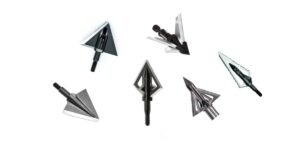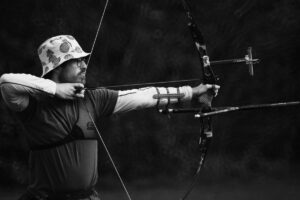Bowstrings come in various configurations. Each bowstring material you come across offers a combination of strength, weight, and resistance to water and abrasion. However, while these characteristics depend on the quality of the material, there is one aspect of a bowstring that you can freely choose: the color.
Bowstring colors are the topic of debate in archery circles.
Contents (Jump to Topic)
ToggleAvailable Bowstring Colors
Nowadays, you can buy bowstrings in nearly every color imaginable. There are the classics, such as black, white, gray, etc. You also have modern colors that were not readily available in the past, including blue, red, yellow, and such. Most recently, neon and fluorescent bowstrings have become considerably popular. The same goes for multicolored strings, which combine two or more strands of a different color.
Popular Color Combinations:
- Red w/ Silver Serving
- Green & Root Beer w/ Black Serving
- Sunset, Black & White w/ Black Serving
- Electric Blue, Flo Green, Flo Pink & Flo Purple w/ Flo Green Serving
- Red & Blue w/ White Pinstripe w/ Black Serving
Surprise!
People are surprised when their strings aren’t the color they selected. In addition to different colored strings, a fluorescent or light-colored serving changes the overall color.
“Contrary to what some believe, light-colored serving becomes translucent, allowing the colors of the string underneath to show through the serving. This will sometimes change the color of the serving entirely, like mixing paint changes the color of paint. For Example, if you were to put flo yellow serving over top of a blue string, it will look green.”
Source: https://www.60xcustomstrings.com/blog/bowstring-color-tips-tricks/
But why should you care about the color of your bowstring anyways? Well, it all has to do with the visual aspect of archery. In some situations, it’s good to be able to see your bowstring clearly. In others, you may want to avoid drawing attention to it.
Let’s discuss several applications and the most suitable bowstring color for each.
Target Shooting
Target shooting is the oldest and consistently popular sport-related to archery. Competitions consist of shooting at a round target set at a distance. For indoor competitions, the length between you and the target is 18 to 25 meters.
For outdoor shooting, it goes up, reaching a minimum of 30 and a maximum of 90 meters. Shooting distance depends on the type of bow competitors use and their age.
Let’s quickly review the target you’ll be aiming for, as it’s closely related to the choice of bowstring color. Although targets can vary in size, they always include ten colored, concentric rings.
Aiming at a Target Shooting Competition
When aiming your bow using a bow sight, the most important thing is that you’re able to see the silhouette of the string. You won’t see the bowstring clearly – this is impossible since your focus is on the target.
Instead, you will see the bowstring as a blurred vertical line. That is precisely why you want to choose a color that makes your bowstring stand out.
Choosing a Bowstring Color for Target Shooting
Your bowstring needs to provide high contrast against the target for the best visibility. However, as we described, the standard archery target consists of several different colors: white, black, blue, red, and yellow. You need a color that will stand out against all or, at least, most of these colors.
At first glance, you might think orange would be the best: it’s bright, noticeable, and, most importantly, it’s not included in the target. But while it’s a decent color choice for a bowstring, orange can sometimes be too bright. When out of focus, bright colors get lost in the background, especially on a sunny day. Therefore, if you want to try an orange bowstring, go for a slightly darker shade of burnt orange and see if that suits you.
For the same reasons as orange, green is another logical choice. However, it sometimes suffers from one drawback: it blends in with nature. While this is rarely a problem with indoor competitions, shooting outdoors can be an issue.
Although there’s no green ring on the target, outdoor backgrounds often include trees and bushes, making it harder for a green string to stand out.
Somewhat contrary to logic, red is an excellent choice for a bowstring. Even though it’s part of the spectrum included in the target, it still somehow manages to stand out. A red bowstring is dark enough for a sunny day and bright enough to pop against the target.
Therefore, even though bowstring color is, to an extent, a personal preference, our choice would be bright red. It’s an excellent all-rounder, especially for beginners.
String Silhouettes Compared

Now, this is an absolute simplification! But you are getting the point.
Bowhunting
Along with target shooting, bow hunting is a prevalent archery discipline. Using a bow and arrows, archers can hunt big game, such as deer and elk (small game hunting is a common option).
Part of the popularity of bow hunting is due to its greater sustainability than rifle hunting. In addition, bowhunting takes more skill, time, and preparation, giving the hunted animal a far greater chance of survival.
When aiming your bow during a hunt, it depends if you are using a modern compounded bow and aim through a peep sight, or you’re shooting a recurve bow with sight, or you are a member of the trad gang – a barebow archer, and you aim using your bowstring.
The Basics of Bowhunting
Bowhunting requires that you engage your target very carefully. Before making the shot, you often need to get close to the animal (or the animal gets close to your stand/blind).
The need for stealth means that bow hunters often utilize camouflage when choosing their hunting equipment. That’s why you see hunters dressed in a complete camo outfit, and some even choose to wear ghillie suits.
The Best Bowstring Color for Hunting
Since camouflage is essential in bow hunting, you might think that green would be the best color choice for your bowstring. That cannot be further from the truth.
As mentioned previously, when aiming with your bowstring, you want to see it as clearly as possible. While hunting, a green bowstring has the opposite effect as it will easily blend in with the environment. After all, green is the color most commonly found in nature.
You already know that your bowstring should provide contrast between itself, the target, and the background. That’s why you need to choose a color that’s not very common on hunting grounds. Neon and fluorescent colors are good choices, as these colors are all but nonexistent in woodland environments.
Bright, flashy colors have an added benefit for hunting gear. Since most of it is covered in camouflage, things can often get lost. Having a splash of color makes your equipment visible should you happen to drop it during your hunt.
Deer
We know what you’re wondering: won’t animals see my screaming pink bowstring? Surprisingly enough, no. Deer, for example, can see blue clearly, but otherwise, they’re red-green colorblind. They have difficulty telling apart red, orange, and green shades of color. This color blindness is why hunters wear bright orange vests: it prevents them from shooting each other while making little to no difference in how deer perceive them.
On top of everything, even if you choose a neon blue bowstring, you don’t need to worry about being noticed in a big game. A bowstring is so thin it will disappear after only a couple of feet of distance. That said, we like the idea of a fluorescent bowstring for hunting. Blue, orange, pink – it’s your choice.
Turkey
You want to be careful when hunting turkey. This is especially important when no blind is present, and you expect close shots. Generally, any bright color (red is probably the worst) will attract their eyeballs; they will then investigate and pick you off.
Twisted colors = better?
Looks more interesting, but honestly makes it way harder to use the silhouette. If you are a compound archer and use a peep sight for aiming purposes… go for it. Neon strings, multicolored strings, basically any string color is fine!
Bowstring Cleaning and Durability
The color of your bowstring can have a noticeable effect on how easy it is to maintain it. In turn, ease of maintenance will prolong the bowstring’s life.
As we all know, there is no everlasting bowstring. While high-tech materials offer superior durability, it is only a matter of time before the string starts to fray. That’s where maintenance comes in: to minimize fraying. You will need to regularly clean and wax your bowstring.
So, what does the color of your bowstring have to do with anything? Well, choosing the right color will enable you to tell if your string needs cleaning. As you use your bow, you get dirt and grime between the fibers of the bowstring. The filth then mixes with the wax, forming a dirty paste. This paste acts as an abrasive, slowly eating away at your bowstring and making it shoot worse in the process.
Choosing the right color will make the grime show through more easily – the dirty spots will quickly turn brown with use. In turn, this will let you know when it’s time to do a cleanup. For this purpose, choose a somewhat lighter shade – anything works except black, brown, and other very dark colors.
Historically Accurate Bowstring Colors
Historical accuracy is one of the things you might need to consider when choosing the color of your bowstring. Most modern archers don’t care about this, as they use cutting-edge bows anyway. However, some take part in historical reenactments or traditional competitions. You don’t see Robin Hood with a neon bowstring, do you?
When choosing a bowstring for your traditional bow, you must first get acquainted with the conventional ways of bow making. Before modern technology, craftsmen called “bowyers” used natural materials to make bowstrings.
Depending on the bow, the string could be made of hemp, silk, linen, as well as animal sinew and hides. This gave bowstrings a distinct color, ranging from off-white to cream.
While traditional materials are still a perfectly suitable choice for a bow, they are no match for their modern counterparts. Therefore, even if you choose to use a traditional bow, you can still upgrade it with some modern tech – namely, a bowstring. However, to keep up with the theme of historical accuracy, choose a suitable color. As we already mentioned, off-white and cream are your safest options.
If you’re looking to get deep into historical archery, you might want to learn a thing or two about your chosen type of bow and its accompanying string. Know that an English longbow has a hemp, linen, or silk string. Hemp is the material of choice for Japanese bows as well.
On the other hand, bows from the Middle East often use sinew for their bowstrings. When on the lookout for a suitable modern equivalent, consider the colors of these natural materials, and try to replicate them on your new bowstring.
Schedule Regular Cleaning Intervals
You don’t need to see the dirt to know that your string needs cleaning. After all, your string will get dirty is very predictable. Just count how many hours of use it takes for your bowstring to get clogged up, and schedule your cleaning intervals accordingly.
Seeing the dirt might be more practical, but it’s not the only way to do things.
Take Better Care of Your Equipment
We mentioned that one of the points of a brightly colored bowstring is to prevent you from losing your bow during a hunt. While this can be handy, it’s not essential. You simply never need to lose sight of your bow. It’s easier said than done, indeed, but it’s not impossible. If you’re serious about style, you’ll make an effort.
Summary
The color of a bowstring can impact your performance. By standing out from its surroundings, a colored bowstring will help your aim noticeably – but only if you’ve chosen the right shade. Light colors will show you exactly when your bow needs cleaning. You will see the dirt you need to remove, thus prolonging the life of your string. We believe red is an excellent all-rounder (except when turkey hunting). It has enough pop to stand out against an archery target as well as a woodland environment. On top of that, it shows grime quickly.








Conversation | 1 comment:
I like my strings to blend in when I hunt so I pick muted natural color tones, or just straight black.